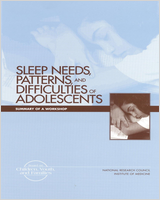From: ADOLESCENT SLEEP PATTERNS AND DAYTIME SLEEPINESS

NCBI Bookshelf. A service of the National Library of Medicine, National Institutes of Health.
Fairfax County teacher Catherine Colglazier described a typical day at her McLean, Virginia, high school, where the doors open at 7:15 a.m. Students come in either fired up on caffeine or straggly and sleepy eyed.
Because McLean High School has block scheduling, she has 90 minutes at 7:20 a.m. to keep students awake and learning through a variety of activities, including SAT preparation, writing, and literature. At 8:30 a.m., no matter how good the teacher is, some kids are dozing off. Why are they so sleepy? Most students in Colglazier's class reported going to bed well after midnight.
One of the issues teachers face in identifying kids with sleep problems is that parents are reluctant to have such a problem be part of any kind of record or referral for their child because it could be misconstrued as a sign of possible drug use. Another reason that adults seem stymied in helping kids with sleep difficulties is that people don't yet know about or believe the research. In many schools, high SAT scores are evidence that young people are successful. While a student may be taking caffeine pills on a regular basis, acceptance to an Ivy League school speaks louder than any concerns teachers or parents might have.
A second issue is money. There are many competing demands on school systems, such as reducing class size and providing competitive salaries. When it comes to devoting substantial funds to adjust school bus availability and scheduling, a change to an earlier starting time doesn't seem to be worth the money.
A third issue is the impact on extracurricular programs. Since the recent tragic shootings in U.S. schools, most school administrators are working hard to provide a range of activities and clubs that make kids feel connected to school, happier, less violent, and less depressed. The young person who wants to create a club for those interested in computer games is just the sort of teenager schools want in their after-school programs. But doing this is difficult if school starts later.
Cultural factors play a role as well. Americans thrive on stress and admire those who are very active. This is reflected in advertisements and movies, and teenagers respond to the popular culture.
From: ADOLESCENT SLEEP PATTERNS AND DAYTIME SLEEPINESS

NCBI Bookshelf. A service of the National Library of Medicine, National Institutes of Health.